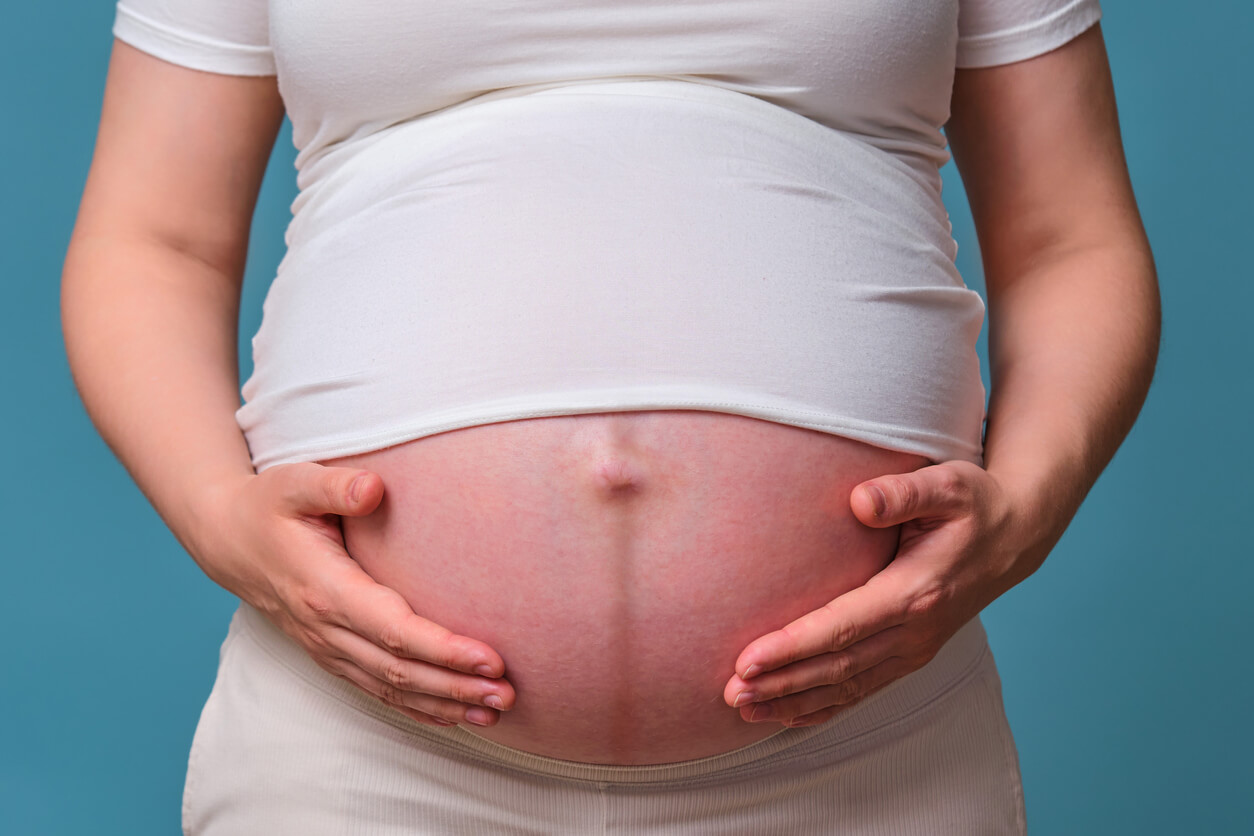A Hard Belly During Pregnancy: Why Does It Occur?

Pregnancy is a stage that’s accompanied by physical changes and its own symptoms, which can be quite annoying and a cause for concern in the mother. One of these sensations is a hard belly. Do you know what causes this phenomenon? In this article, you’ll find out the causes of a hard belly during pregnancy and when you should go to the doctor.
What does a hard belly during pregnancy mean?
Throughout pregnancy, you may notice that your belly becomes tense and hard at times and sometimes you may feel a strange pain in the abdominal area. This causes some concern and may suggest that something’s wrong with your baby or that labor has come early.
However, although it’s annoying, it’s a fairly common and normal symptom of pregnancy, which has to do with the physical adaptations that the uterus must make to accommodate the fetus. And later, it also has to do with the modifications necessary for childbirth.
The most common thing is to feel the hard belly at night, when the muscles are more relaxed and our brain more “free of stimuli” to perceive it. First of all, you should know that the intensity of the discomfort is closely related to the cause that produces it.

Why causes a hard belly during pregnancy?
As we’ve anticipated, the causes that justify a hard belly vary according to the stages of pregnancy. Let’s see them in detail, trimester by trimester.
First trimester
From the beginning of pregnancy, mothers may notice that at certain times, their belly becomes tense. This is expected, as the uterus begins its function and must begin to elongate its tissues.
However, at this stage, it is important to assess the symptoms that accompany this sensation in order to clarify the cause. Among them, the following stand out:
- Stretching of the uterine muscle: From the first trimester, the uterus begins its transformation. Its size changes, its walls stretch, as do the ligaments that support it. As you can imagine, its muscles are quite strong and offer some resistance to stretching, which justifies the tightening of the belly. The intensity of this discomfort can vary from one woman to another, but in general, it occurs in short periods of time.
- Gastrointestinal discomfort: Hormonal action on the digestive system causes a slowdown in intestinal transit. Consequently, constipation, abdominal heaviness, and gas are experienced. All these phenomena distend the walls of the belly and favor momentary hardening.
- Spontaneous miscarriage: The first 12 weeks of gestation are the most delicate, as the largest number of spontaneous miscarriages occurs during this period. One of the symptoms that characterize them is the hardening of the belly, but in addition, there are very intense pains in the lower area and blood loss. If you experience these symptoms, you should go to the emergency room right away.
Second trimester
In the second trimester, the mother begins to feel the baby’s movements and, in addition, the belly grows considerably. This gives rise to the appearance of false contractions, which usually accompany the hardening of the belly. Let’s look at them in detail.
- Baby movements: From approximately week 20, you begin to feel the baby’s movements inside the uterus. At first, they’re perceived as flutters and tickles, but as the baby grows, they become more noticeable and abrupt. This often causes the belly to become hard and change shape, either rising or shifting sideways.
- Braxton Hicks contractions: These are called “false contractions” and appear around week 28 in first-timers. The purpose of them is to prepare the uterus for the moment of childbirth and although they can be somewhat annoying, they’re brief and painless. Furthermore, they occur sporadically and without a rhythmic pattern.
Third trimester

In the third trimester, this symptom becomes even more frequent and this is especially related to uterine contractions. In this sense, the false contractions become more repetitive, although they’re still irregular and arrhythmic. Its function at this stage is to soften the cervix and accommodate the baby in the correct position.
We mustn’t leave aside the fact that the baby has already gained considerable size and weight and that its movements are becoming more forceful and abrupt. This also justifies the tightening of the mother’s belly when the baby performs them.
Finally, from week 37, you need to pay attention to the moment in which the belly tightens, because if it’s accompanied by frequent and painful contractions or the loss of amniotic fluid, this can indicate the beginning of labor.
When to go to the doctor?
First of all, it’s important to always assess the symptoms that accompany a hard belly during pregnancy. Although it’s an expected symptom, it can also suggest some gestational complication.
It’s advisable to go to get an assessment with a specialist when any of the following scenarios occur:
- The hardening is accompanied by abdominal pain and vaginal bleeding.
- When this sensation is perceived several times a day and with pain.
- If the belly hardens and fetal movements aren’t perceived.
- When accompanied by frequent contractions (about 4 in 1 hour) and pain.
- If this symptom responds to the onset of labor.
In general, if this sensation becomes bothersome and causes you concern, it’s best to discuss it with your doctor or midwife. After the physical and ultrasound examination, the specialists will be able to assess whether it’s indeed a common manifestation of this stage or if it has to do with an alteration in the pregnancy.
Pregnancy is a stage that’s accompanied by physical changes and its own symptoms, which can be quite annoying and a cause for concern in the mother. One of these sensations is a hard belly. Do you know what causes this phenomenon? In this article, you’ll find out the causes of a hard belly during pregnancy and when you should go to the doctor.
What does a hard belly during pregnancy mean?
Throughout pregnancy, you may notice that your belly becomes tense and hard at times and sometimes you may feel a strange pain in the abdominal area. This causes some concern and may suggest that something’s wrong with your baby or that labor has come early.
However, although it’s annoying, it’s a fairly common and normal symptom of pregnancy, which has to do with the physical adaptations that the uterus must make to accommodate the fetus. And later, it also has to do with the modifications necessary for childbirth.
The most common thing is to feel the hard belly at night, when the muscles are more relaxed and our brain more “free of stimuli” to perceive it. First of all, you should know that the intensity of the discomfort is closely related to the cause that produces it.

Why causes a hard belly during pregnancy?
As we’ve anticipated, the causes that justify a hard belly vary according to the stages of pregnancy. Let’s see them in detail, trimester by trimester.
First trimester
From the beginning of pregnancy, mothers may notice that at certain times, their belly becomes tense. This is expected, as the uterus begins its function and must begin to elongate its tissues.
However, at this stage, it is important to assess the symptoms that accompany this sensation in order to clarify the cause. Among them, the following stand out:
- Stretching of the uterine muscle: From the first trimester, the uterus begins its transformation. Its size changes, its walls stretch, as do the ligaments that support it. As you can imagine, its muscles are quite strong and offer some resistance to stretching, which justifies the tightening of the belly. The intensity of this discomfort can vary from one woman to another, but in general, it occurs in short periods of time.
- Gastrointestinal discomfort: Hormonal action on the digestive system causes a slowdown in intestinal transit. Consequently, constipation, abdominal heaviness, and gas are experienced. All these phenomena distend the walls of the belly and favor momentary hardening.
- Spontaneous miscarriage: The first 12 weeks of gestation are the most delicate, as the largest number of spontaneous miscarriages occurs during this period. One of the symptoms that characterize them is the hardening of the belly, but in addition, there are very intense pains in the lower area and blood loss. If you experience these symptoms, you should go to the emergency room right away.
Second trimester
In the second trimester, the mother begins to feel the baby’s movements and, in addition, the belly grows considerably. This gives rise to the appearance of false contractions, which usually accompany the hardening of the belly. Let’s look at them in detail.
- Baby movements: From approximately week 20, you begin to feel the baby’s movements inside the uterus. At first, they’re perceived as flutters and tickles, but as the baby grows, they become more noticeable and abrupt. This often causes the belly to become hard and change shape, either rising or shifting sideways.
- Braxton Hicks contractions: These are called “false contractions” and appear around week 28 in first-timers. The purpose of them is to prepare the uterus for the moment of childbirth and although they can be somewhat annoying, they’re brief and painless. Furthermore, they occur sporadically and without a rhythmic pattern.
Third trimester

In the third trimester, this symptom becomes even more frequent and this is especially related to uterine contractions. In this sense, the false contractions become more repetitive, although they’re still irregular and arrhythmic. Its function at this stage is to soften the cervix and accommodate the baby in the correct position.
We mustn’t leave aside the fact that the baby has already gained considerable size and weight and that its movements are becoming more forceful and abrupt. This also justifies the tightening of the mother’s belly when the baby performs them.
Finally, from week 37, you need to pay attention to the moment in which the belly tightens, because if it’s accompanied by frequent and painful contractions or the loss of amniotic fluid, this can indicate the beginning of labor.
When to go to the doctor?
First of all, it’s important to always assess the symptoms that accompany a hard belly during pregnancy. Although it’s an expected symptom, it can also suggest some gestational complication.
It’s advisable to go to get an assessment with a specialist when any of the following scenarios occur:
- The hardening is accompanied by abdominal pain and vaginal bleeding.
- When this sensation is perceived several times a day and with pain.
- If the belly hardens and fetal movements aren’t perceived.
- When accompanied by frequent contractions (about 4 in 1 hour) and pain.
- If this symptom responds to the onset of labor.
In general, if this sensation becomes bothersome and causes you concern, it’s best to discuss it with your doctor or midwife. After the physical and ultrasound examination, the specialists will be able to assess whether it’s indeed a common manifestation of this stage or if it has to do with an alteration in the pregnancy.
All cited sources were thoroughly reviewed by our team to ensure their quality, reliability, currency, and validity. The bibliography of this article was considered reliable and of academic or scientific accuracy.
- American Pregnancy Association. (2015) Las Contracciones de Braxton-Hicks : las Causas y el Tratamiento. Recuperado de: https://americanpregnancy.org/es/healthy-pregnancy/labor-and-birth/braxton-hicks/
- American Pregnancy Association (2021). El Tamaño del Útero Durante el Embarazo. Recuperado de: https://americanpregnancy.org/es/healthy-pregnancy/pregnancy-health-wellness-healthy-pregnancy/uterus-size-during-pregnancy/
- Carvajal, J. (2018). Manual de Obstetricia y Ginecología. Chile. 9na Edición.
- Klein, S; Miller, S; Thomson, F. (2013). Un libro para las parteras. EEUU. Recuperado de: https://es.hesperian.org/hhg/Un_libro_para_parteras
This text is provided for informational purposes only and does not replace consultation with a professional. If in doubt, consult your specialist.








